THE CAMEL
From Wikipedia, the free encyclopedia
A camel is an even-toed ungulate within the genus Camelus, bearing distinctive fatty deposits known as "humps" on its back. The two surviving species of camel are the dromedary, or one-humped camel, which is native to the Middle East and the Horn of Africa; and the Bactrian, or two-humped camel, which inhabits Central Asia. Both species have been domesticated; they provide milk, meat, hair for textiles or goods such as felted pouches, and are working animals.
Etymology
The term "camel" is derived via Latin and Greek (camelusand kamēlos respectively) from Hebrew or Phoenician gāmāl, possibly from a verb root meaning to bear or carry (related toArabic jamala).[4][5]
"Camel" is also used more broadly to describe any of the six camel-like mammals in the family Camelidae: the two true camels, and the four South American camelids: the llamaand alpaca are called "New World camels", while theguanaco and vicuña are called "South American camels".[6][7]
Biology
The average life expectancy of a camel is 40 to 50years.[8][9] A full-grown adult camel stands 1.85 m (6 ft 1 in) at the shoulder and 2.15 m (7 ft 1 in) at the hump.[10]Camels can run at up to 65 km/h (40 mph) in short bursts and sustain speeds of up to 40 km/h (25 mph).[11] Bactrian camels weigh 300 to 1,000 kg (660 to 2,200 lb) and dromedaries 300 to 600 kg (660 to 1,300 lb).
The male dromedary camel has in its throat an organ called a dulla, a large, inflatable sac he extrudes from his mouth when in rut to assert dominance and attract females. It resembles a long, swollen, pink tongue hanging out of the side of its mouth.[12] Camels mate by having both male and female sitting on the ground, with the male mounting from behind. The male usually ejaculates three or four times within a single mating session.[13][14] Camels are the only ungulates to mate in a sitting position.[15]
Ecological and behavioral adaptations
Camels do not directly store water in their humps as was once commonly believed. The humps are actually reservoirs of fatty tissue: concentrating body fat in their humps minimizes the insulating effect fat would have if distributed over the rest of their bodies, helping camels survive in hot climates.[16][17] When this tissue is metabolized, it yields more than one gram of water for every gram of fat processed. This fat metabolization, while releasing energy, causes water to evaporate from the lungs during respiration (as oxygen is required for the metabolic process): overall, there is a net decrease in water.[18][19]
Camels have a series of physiological adaptations that allow them to withstand long periods of time without any external source of water.[17] Unlike other mammals, their red blood cells are oval rather than circular in shape. This facilitates the flow of red blood cells during dehydration[21] and makes them better at withstanding high osmotic variation without rupturing when drinking large amounts of water: a 600 kg (1,300 lb) camel can drink 200 L (53 US gal) of water in three minutes.[22][23]
Camels are able to withstand changes in body temperature and water consumption that would kill most other animals. Their temperature ranges from 34 °C (93 °F) at dawn and steadily increases to 40 °C (104 °F) by sunset, before they cool off at night again.[17] Maintaining the brain temperature within certain limits is critical for animals; to assist this, camels have a rete mirabile, a complex of arteries and veins lying very close to each other which utilizes countercurrent blood flow to cool blood flowing to the brain.[24] Camels rarely sweat, even when ambient temperatures reach 49 °C(120 °F).[8] Any sweat that does occur evaporates at the skin level rather than at the surface of their coat; the heat of vaporization therefore comes from body heat rather than ambient heat. Camels can withstand losing 25% of their body weight to sweating, whereas most other mammals can withstand only about 12–14% dehydration before cardiac failure results from circulatory disturbance.[23]
When the camel exhales, water vapor becomes trapped in their nostrils and is reabsorbed into the body as a means to conserve water.[25] Camels eating green herbage can ingest sufficient moisture in milder conditions to maintain their bodies' hydrated state without the need for drinking.[26]
The camels' thick coats insulate them from the intense heat radiated from desert sand, and a shorn camel has to sweat 50% more to avoid overheating.[27] During the summer the coat becomes lighter in color, reflecting light as well as helping avoid sunburn.[23] Its long legs help by keeping them farther from the hot ground, which can heat up to 70 °C (158 °F).[28][29]Dromedaries have a pad of thickend tissue located over thesternum called the pedestal. When the animal lies down in a sternal recumbency position, the pedestal raises the body from the hot surface and allows cooling air to pass under the body.[24]
Camels' mouths have a thick leathery lining, allowing them to chew thorny desert plants. Long eyelashes and ear hairs, together with nostrils that can close, form a barrier against sand. If sand gets lodged in their eyes, they can dislodge it using their transparent third eyelid. The camels' gait and widened feet help them move without sinking into the sand.[28][30][31]
The kidneys and intestines of a camel are very efficient at reabsorbing water. Camel urine comes out as a thick syrup, and camel feces are so dry, the Bedouins use it to fuel fires.[32][33][34][35]
Camels' immune system differs from those of other mammals. Normally, the Y-shaped antibody molecules consist of two heavy (or long) chains along the length of the Y, and two light (or short) chains at each tip of the Y. Camels, in addition to these, also have antibodies made of only two heavy chains, a trait that makes them smaller and more durable. These "heavy-chain-only" antibodies, discovered in 1993, are thought to have developed 50 million years ago, after camelids split from ruminants and pigs.[36]
Genetics
The karyotypes of different camelid species have been studied earlier by many groups,[37][38][39][40][41][42] but no agreement on chromosome nomenclature of camelids has been reached. A 2007 study flow sorted camel chromosomes, building on the fact that camels have 37 pairs of chromosomes (2n=74), and found that the karyotime consisted of one metacentric, three submetacentric, and 32 acrocentric autosomes. The Y is a small metacentric chromosome, while the X is a large metacentric chromosome.[43]
According to molecular data, the New World and Old World camelids diverged 11 million years ago.[44] In spite of this, these species can still hybridize and produce fertile offspring.[45] The hybrid camel has one hump, though it has an indentation 4–12 cm (1.6–4.7 in) deep that divides the front from the back. The hybrid is 2.15 m (7 ft 1 in) at the shoulder and 2.32 m (7 ft 7 in) tall at the hump. It weighs an average of 650 kg (1,400 lb) and can carry around 400 to 450 kg (880 to 990 lb), which is more than either the dromedary or Bactrian can.[46]
The cama is a camel–llama hybrid bred by scientists who wanted to see how closely related the parent species were.[47] The scientists collected semen from a camel via an artificial vagina and inseminated a llama after stimulating ovulation with gonadotrophin injections.[48] The cama has ears halfway between the length of camel and llama ears, no hump, longer legs than the llama, and partially cloven hooves.[49][50]According to cama breeder Lulu Skidmore, cama have "the fleece of the llamas" and "the strength and patience of the camel".[48] Like the mule, camas are sterile, despite both parents having the same number of chromosomes.[48]
Evolution
See also: Camelops
The earliest known camel, called Protylopus, lived in North America 40 to 50 million years ago (during the Eocene).[14] It was about the size of a rabbit and lived in the open woodlands of what is now South Dakota.[51][52] By 35 million years ago, the Poebrotherium was the size of a goat and had many more traits similar to camels and llamas.[53][54] The hoofedStenomylus, which walked on the tips of its toes, also existed around this time, and the long-necked Aepycamelus evolved in the Miocene.[55]
The direct ancestor of all modern camels, Procamelus, existed in the upper Miocone and lower Pliocene.[56] Around 3–5 million years ago, the North American Camelidae spread to South America via the Isthmus of Panama, where they gave rise to llamas and related animals, and to Asia via the Bering land bridge.[14][51][52] Surprising finds of fossil Paracamelus on Ellesmere Island beginning in 2006 in the high Canadian Arctic indicate the dromedary is descended from a larger, boreal browser whose hump may have evolved as an adaptation in a cold climate.[57][58]
The last camel native to North America was Camelops hesternus, which vanished along with horses, short-faced bears, mammoths and mastodons, ground sloths, sabertooth cats, and many other megafauna, coinciding with the migration of humans from Asia.[2][59]
Domestication
Most camels surviving today are domesticated.[35][60]Along with many other megafauna in North America, the original wild camels were wiped out during the spread ofNative Americansfrom Asia into North America, 12,000 to 10,000 years ago.[2][59] The only wild camels left are the Bactrian camels of the Gobi Desert.[9]
Like the horse, before their extinction in their native land, they spread across the Bering land bridge, moving the opposite direction from the Asian immigration to America, to survive in the Old World and eventually be domesticated and spread globally by humans.
Dromedaries may have first been domesticated by humans in southern Arabia, around 3,000 BC, the Bactrian in central Asia around 2,500 BC.[14][61][62]
Military uses
Main article: Camel cavalry
By at least 1200 BC, the first camel saddles had appeared, and Bactrian camels could be ridden. The first Arabian saddle was positioned to the back of the camel, and control of the Bactrian camel was exercised by means of a stick. However, between 500–100 BC, Bactrian camels attained military use. New saddles, which were inflexible and bent, were put over the humps and divided the rider's weight over the animal. In the seventh century BC, the military Arabian saddle appeared, which improved the saddle design again slightly.[63]
Camel cavalries have been used in wars throughout Africa, the Middle East, and into modern-day Border Security Force ofIndia (though as of July 2012, the BSF has planned the replacement of camels with ATVs). The first use of camel cavalries was in the Battle of Qarqar in 853 BC.[64][65][66] Armies have also used camels as freight animals instead of horses and mules.[67][68]
In the East Roman Empire, the Romans used auxiliary forces known as dromedarii, whom they recruited in desert provinces.[69][70] The camels were used mostly in combat because of their ability to scare off horses at close ranges (horses are afraid of the camels' scent),[15] a quality famously employed by theAchaemenid Persians when fighting Lydia in the Battle of Thymbra.[46][71][72]
19th and 20th centuries
- The United States Army established the U.S. Camel Corps, which was stationed in California in the late 19th century.[15]One may still see stables at the Benicia Arsenal in Benicia, California, where they nowadays serve as the Benicia Historical Museum.[73] Though the experimental use of camels was seen as a success (John B. Floyd, Secretary of War in 1858, recommended that funds be allocated towards obtaining a thousand more camels), the outbreak of the American Civil War saw the end of the Camel Corps: Texas became part of the Confederacy, and most of the camels were left to wander away into the desert.[68]
- France created a méhariste camel corps in 1912 as part of the Armée d'Afrique in the Sahara[74] in order to exercise greater control over the camel-riding Tuareg and Arab insurgents, as previous efforts to defeat them on foot had failed.[75] The camel-mounted units remained in service until the end of French rule over Algeria in 1962.[76]
- In 1916, the British created the Imperial Camel Corps. It was originally used to fight the Senussi, but was later used in the Sinai and Palestine Campaign in World War I. The Imperial Camel Corps comprised infantrymen mounted on camels for movement across desert, though they dismounted at battle sites and fought on foot. After July 1918, the Corps began to become run down, receiving no new reinforcements, and was formally disbanded in 1919.[72]
- In World War I, the British Army also created the Egyptian Camel Transport Corps, which consisted of a group of Egyptian camel drivers and their camels. The Corps supported British war operations inSinai, Palestine, and Syria by transporting supplies to the troops.[77][78][79]
- The Somaliland Camel Corps was created by colonial authorities in British Somaliland in 1912; it was disbanded in 1944.[80]
- Bactrian camels were used by Romanian forces during World War II in the Caucasian region.[81]
- The Bikaner Camel Corps of British India fought alongside the British Indian Army in World Wars I and II.[82]
- The Tropas Nómadas (Nomad Troops) were an auxiliary regiment of Sahrawi tribesmen serving in the colonial army in Spanish Sahara (today Western Sahara). Operational from the 1930s until the end of the Spanish presence in the territory in 1975, the Tropas Nómadas were equipped with small arms and led by Spanish officers. The unit guarded outposts and sometimes conducted patrols on camelback.[83][84]
Food uses
Dairy
Camel milk is a staple food of desert nomad tribes and is sometimes considered a meal in and of itself; a nomad can live on only camel milk for almost a month.[15][32][85][86] Camel milk is rich in vitamins, minerals, proteins, and immunoglobulins;[87]compared to cow's milk, it is lower in fat and lactose,[88] and higher in potassium, iron, and vitamin C.[10] Bedouins believe the curative powers of camel milk are enhanced if the camel's diet consists of certain desert plants.[15][89] Camel milk can readily be made into a drinkable yogurt, as well as butter or cheese, though the yields for cheese tend to be low.[15][88]
Camel milk cannot be made into butter by the traditional churning method. It can be made if it is soured first, churned, and a clarifying agent added.[15] Until recently, camel milk could not be made into camel cheese becauserennet was unable to coagulate the milk proteins to allow the collection of curds.[90] Developing less wasteful uses of the milk, the FAO commissioned Professor J.P. Ramet of the École Nationale Supérieure d'Agronomie et des Industries Alimentaires, who was able to produce curdling by the addition of calcium phosphate and vegetable rennet.[88] The cheese produced from this process has low levels of cholesterol and is easy to digest, even for the lactose intolerant.[91][92] The sale of camel cheese is limited owing to the small output of the few dairies producing camel cheese and the absence of camel cheese in local (West African) markets.[88] Cheese imports from countries that traditionally breed camels are difficult to obtain due to restrictions on dairy imports from these regions.[93]
Camel milk has been made into ice cream in a Netherlands camel farm.[94]
Meat
A camel carcass can provide a substantial amount of meat. The male dromedary carcass can weigh 300–400 kg (700–900 lb), while the carcass of a male Bactrian can weigh up to 650 kg (1,400 lb). The carcass of a female dromedary weighs less than the male, ranging between 250 and 350 kg (550 and 770 lb).[14]The brisket, ribs and loin are among the preferred parts, and the hump is considered a delicacy.[95] The hump contains "white and sickly fat", which can be used to make the khli (preserved meat) of mutton, beef, or camel.[96] Camel meat is reported to taste like coarse beef, but older camels can prove to be very tough,[10][14] although camel meat becomes more tender the more it is cooked.[97] The Abu Dhabi Officers' Club serves a camel burger mixed with beef or lamb fat in order to improve the texture and taste.[98] In Karachi, Pakistan, some restaurants prepare nihari from camel meat.[99]
Camel meat has been eaten for centuries. It has been recorded by ancient Greek writers as an available dish in ancient Persia at banquets, usually roasted whole.[100] The ancient Roman emperor Heliogabalusenjoyed camel's heel.[32] Camel meat is still eaten in certain regions, including Somalia, Djibouti, Saudi Arabia, Egypt, Libya, Sudan, Kazakhstan, and other arid regions where alternative forms of protein may be limited or where camel meat has had a long cultural history.[14][32][95] Camel blood is also consumable, as is the case among pastoralists in northern Kenya, where camel blood is drunk with milk and acts as a key source of iron, vitamin D, salts and minerals.[14][95][101] Camel meat is also occasionally found inAustralian cuisine: for example, a camel lasagna is available in Alice Springs.[100][101]
A 2005 report issued jointly by the Saudi Ministry of Health and the United States Centers for Disease Control and Prevention details cases of human bubonic plague resulting from the ingestion of raw camel liver.[102]
Religion
Islam
Camel meat is halal for Muslims. However, according to some Islamic schools of thought, a state of impurity is brought on by the consumption of it. Consequently, these schools hold that Muslims must perform wudhu (ablution) before the next time they pray after eating camel.[103]
Also, some Islamic schools of thought consider it haraam for a Muslim to perform salah in places where camels lie, as it is said to be a dwelling place of shaytan.[103]
According to ahadith collected by Bukhari and Muslim, Muhammad ordered a certain group of people to drink camel milk and urine as a medicine.[104][105] However, according to Abū Ḥanīfa, the drinking of camel urine, while not forbidden (ḥaram), is disliked (makrūh) in Islam.[106]
Judaism
See also: Taboo food and drink
According to Jewish tradition, camel meat and milk are not kosher.[107] Camels possess only one of the two kosher criteria; although they chew their cud, they do not possess cloven hooves:[108]
Nevertheless these shall ye not eat of them that only chew the cud, or of them that only part the hoof: the camel, because he cheweth the cud but parteth not the hoof, he is unclean unto you.—Leviticus 11:4[109]
Distribution and numbers
There are around 14 million camels alive as of 2010, with 90% being dromedaries.[110] Dromedaries alive today are domesticated animals (mostly living in theHorn of Africa, the Sahel, Maghreb, Middle East andSouth Asia). The Horn region alone has the largest concentration of camels in the world,[20] where the dromedaries constitute an important part of local nomadic life. They provide nomadic people in Somalia (which has the largest camel herd in the world)[14] and Ethiopia with milk, food, and transportation.[86][111][112][113]
The Bactrian camel is, as of 2010, reduced to an estimated 1.4 million animals, most of which domesticated.[35][110][114] The only truly wild Bactrian camels, of which there are less than one thousand, are thought to inhabit the Gobi Desert in China and Mongolia.[9][115]
The largest population of feral camels is in Australia. There are around 700,000 feral dromedary camels in central parts of Australia, descended from those introduced as a method of transport in the 19th and early 20th centuries.[101][110][116] This population is growing about 8% per year.[117] Representatives of the Australian government have culled more than 100,000 of the animals in part because the camels use too much of the limited resources needed by sheep farmers.[118]
A small population of introduced camels, dromedaries and Bactrians, wandered through Southwest United States after having been imported in the 1800s as part of the U.S. Camel Corps experiment. When the project ended, they were used as draft animals in mines and escaped or were released. Twenty-five U.S. camels were bought and imported to Canada during the Cariboo Gold Rush.[68]
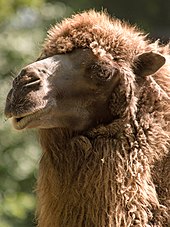


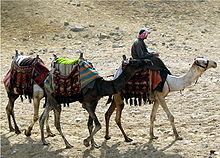
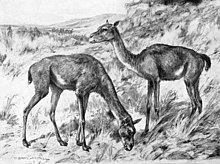
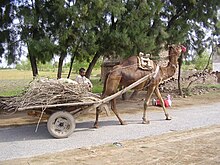


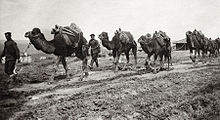
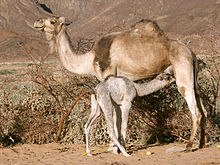
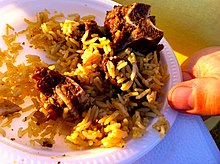


No comments:
Post a Comment